オランダのアムステルダム国立美術館で日清戦争の絵を見つけたよ!!!!!
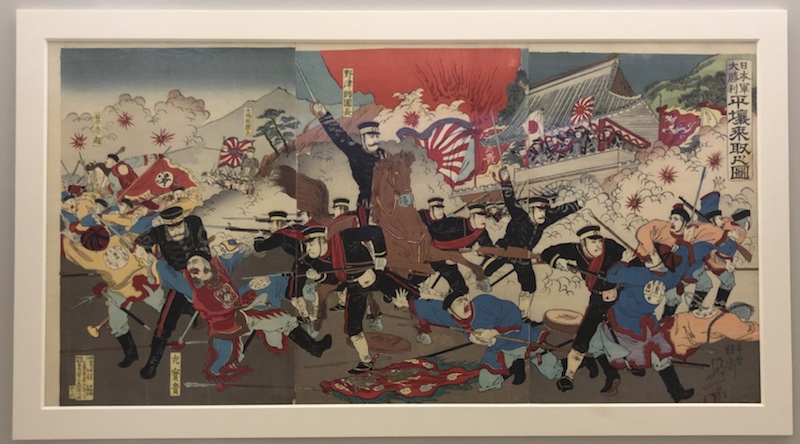
オランダ「アムステルダム国立美術館」で日清戦争はどのように解説されているのか、英語から翻訳してみた
・オランダのアムステルダム国立美術館で日清戦争はどのように伝えられているのか?
・The First Sino-Japanese War:日清戦争
・The Occupation of Jiuliancheng in China by our Soldiers:我兵清国九連城占領
・Great Triumph for the Japanese Army: the Capture of Pyongyang:日本軍大勝利 平壌の図
・The Japanese and Chinese Fleets in a Fierce Encounter off Dagushan:日清海軍大狐山沖激戦図
・Our Fleet Crushing the Chinese Fleet off Dagushan:大狐山沖我艦清鑑撃破ス
・Enemy Ships Detrerred at Haiyangdao:海洋嶋附近ニ敵艦ヲ打沈
・Great Victory of the Japanese Army at Asan in Korea:朝鮮牙山日本陸軍大勝利
・The triumphant Return of the Japanese Army after the Great Victory at Seonghwan:日本兵凱旋の図
・Flowers for the Imperial Headquarters in HIroshima:広島大本営行幸の図
・日清戦争の絵は絵として興味深く、高い表現力に圧倒される
目次
- ・オランダのアムステルダム国立美術館で日清戦争はどのように伝えられているのか?
- ・The First Sino-Japanese War:日清戦争
- ・The Occupation of Jiuliancheng in China by our Soldiers:我兵清国九連城占領
- ・Great Triumph for the Japanese Army: the Capture of Pyongyang:日本軍大勝利 平壌の図
- ・The Japanese and Chinese Fleets in a Fierce Encounter off Dagushan:日清海軍大狐山沖激戦図
- ・Our Fleet Crushing the Chinese Fleet off Dagushan:大狐山沖我艦清鑑撃破ス
- ・Enemy Ships Detrerred at Haiyangdao:海洋嶋附近ニ敵艦ヲ打沈
- ・Great Victory of the Japanese Army at Asan in Korea:朝鮮牙山日本陸軍大勝利
- ・The triumphant Return of the Japanese Army after the Great Victory at Seonghwan:日本兵凱旋の図
- ・Flowers for the Imperial Headquarters in HIroshima:広島大本営行幸の図
- ・日清戦争の絵は絵として興味深く、高い表現力に圧倒される
・オランダのアムステルダム国立美術館で日清戦争はどのように伝えられているのか?
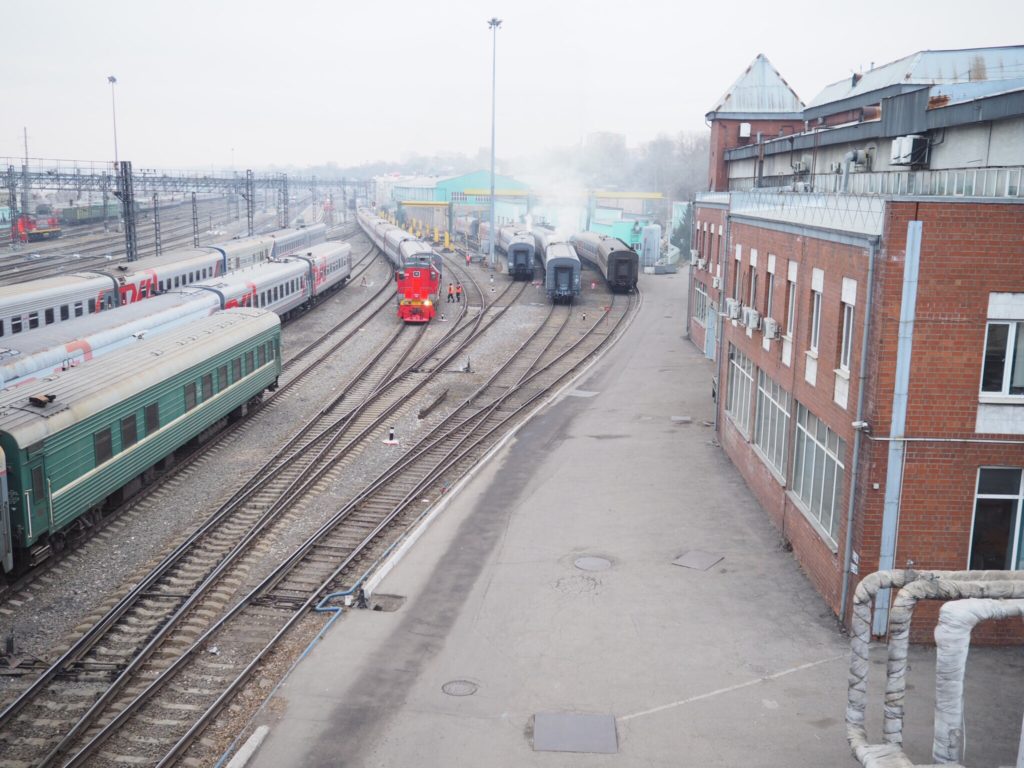
2018年の真冬の季節に、ぼくはロシア・シベリア鉄道の旅をした。日本に近い極東の街・ウラジオストクから凍てつくようなシベリアの大地を彷徨い、最終的には首都・モスクワ、そして華やかなサンクトペテルブルクまで移動し、さらには北極圏の街・ムルマンスクまで北上して、1ヶ月間の渡るぼくのロシアの旅は幕を閉じた。
ムルマンスクの次は陸路でフィンランドへとバス移動し、そしてそのままヨーロッパ周遊の旅に出た。フィンランド、エストニア、ラトビア、リトアニア、チェコ、ポーランド、ハンガリー、オーストリア、スイス、フランス、ベルギーと巡り、最後の最後にはオランダのアムステルダムにたどり着いた。偶然にもぼくのシベリア鉄道の旅〜ヨーロッパ周遊の旅の合計の危険は何と100日間だった。
ヨーロッパの旅の最終目的地として、ぼくが選んだ場所はアムステルダムの国立美術館だった。有名どころではレンブラントの「夜警」やフェルメールの「手紙を読む青衣の女」「恋文」「デフルトの小路」などの数々の名作を鑑賞した後で、地下の階に行くとなんとそこは日本を含むアジア地域の芸術作品の展示エリアになっていた。100日間も日本を離れていたので日本の情緒や感性に久々に触れた喜びからか、ぼくの中ではこの地下のエリアが最も印象に残っている。そこでは日本の色鮮やかな着物、禅の思想を思わせるような絵画、聖徳太子の像や仁王像、仏像などが立ち並び心を奪われた。これから帰る日本という祖国の繊細な美しさを、ユーラシア大陸の西の果てで再認識できたことには何か意味があるような気がしてならなかった。
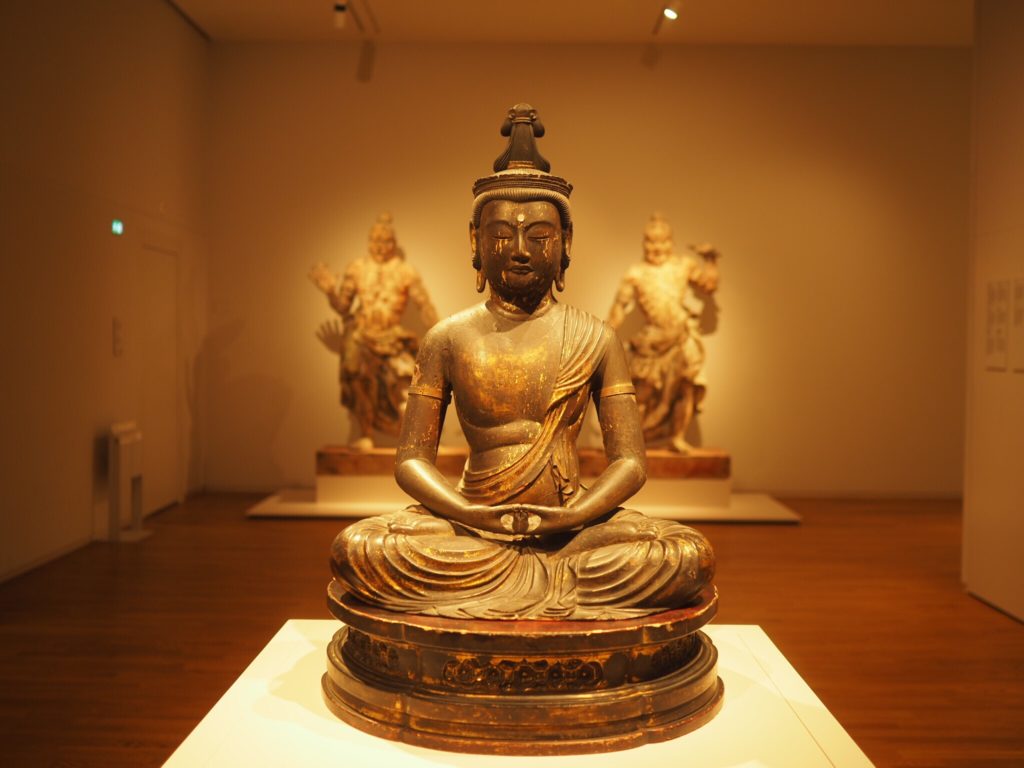
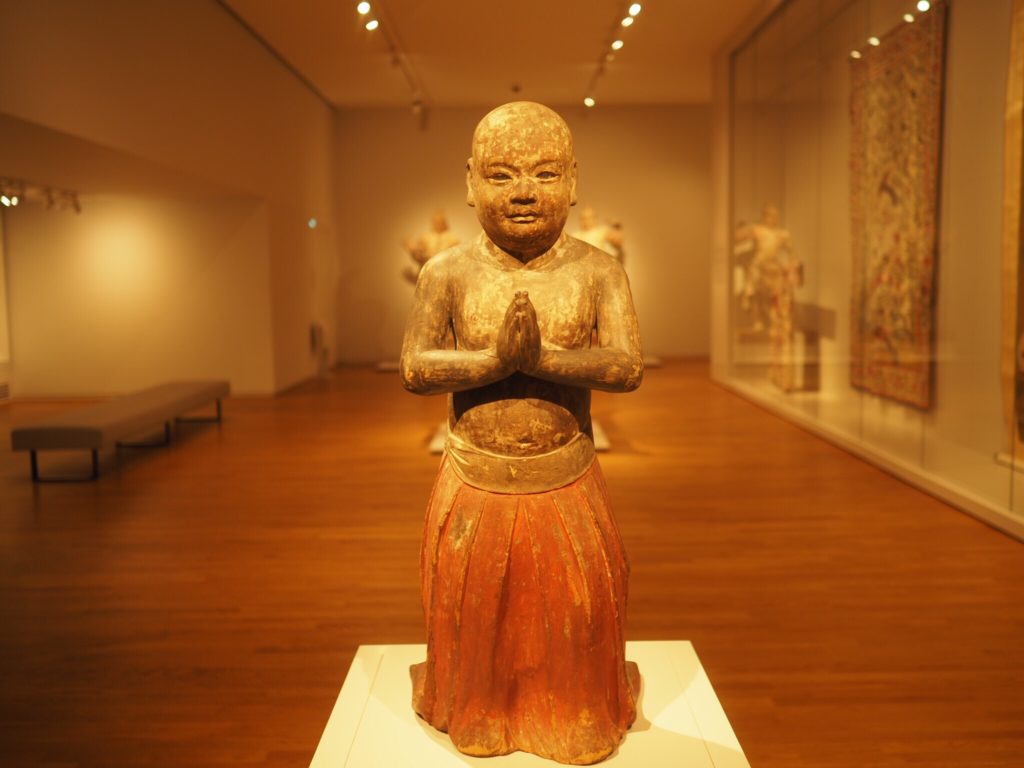


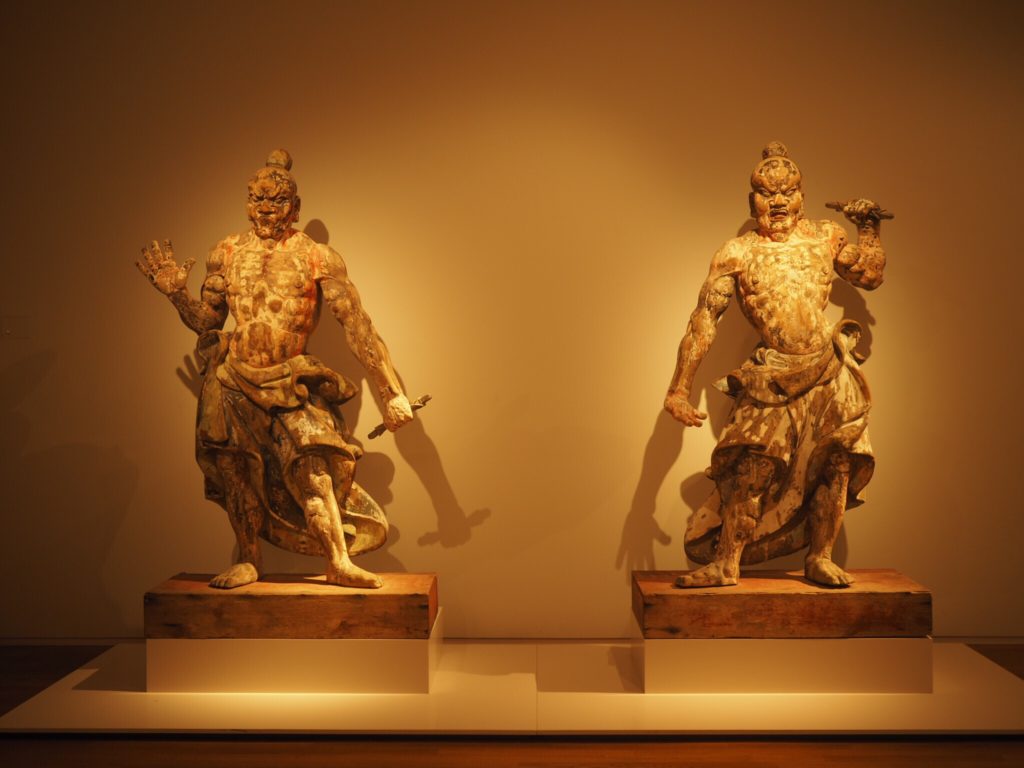
そのようなまさに典型的な”日本の美”が溢れていたアムステルダム国立美術館に、ひとつだけ異質な展示があった。それが日本人によって作られた日清戦争の絵画だった。人々の間で意見が分かれそうなこのような政治的な作品が美術館に並んでいるとはなんとも驚きだったし、違和感があった。見ていると日本人の戦争への意欲や興味を高揚させるために、日本軍の強さを誇らしげに強調しているように見えるし、おそらくそういう目的のために作られた絵なのだろう。絵柄が西洋画とも浮世絵とも違う独特なものだし、確かにこれはこれで芸術的な価値があるのかもしれない。それぞれの絵にはきちんと解説が添えられていた。
果たしてこの西洋のオランダで、日清戦争はどのように解説され人々に伝えられているのだろうか。ぼくはその点が非常に気になったし興味があったので、解説の英語を全て翻訳してみることにした。そしてどうせならひとりで納得するだけではなく、このブログでその翻訳を共有し、アムステルダム国立美術館で日清戦争がどのように解説されているかを分かち合おうと思った次第である。以下はアムステルダム国立美術館の日清戦争の解説文。ではどうぞ!
・The First Sino-Japanese War:日清戦争
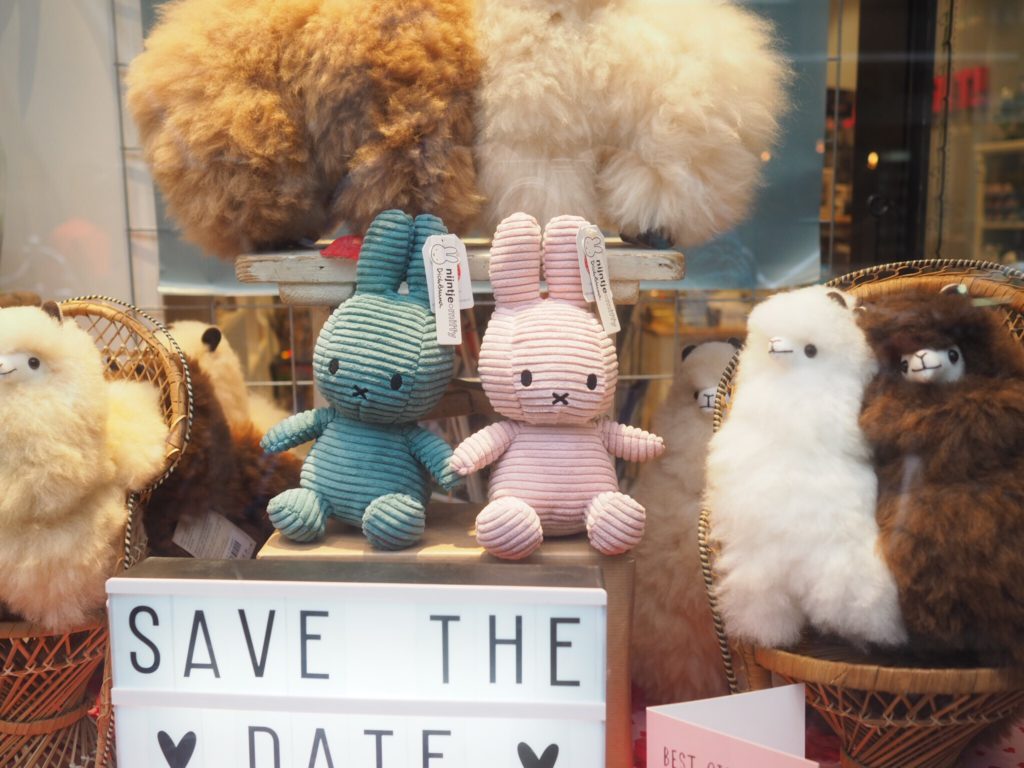
The Sino-Japanese War (1894-1895) revolved around authority over Korea.
日清戦争(1894年〜1895年)は、朝鮮の権利をめぐって巻き起こった。
While Korea had traditionally been influenced by China, at the end of the 19th century Japan believed it had a duty to assume leadership.
朝鮮は昔から中国に影響を受けていた一方で、19世紀末には、日本は自分が朝鮮のリーダーシップをとる義務があると信じていた。
In the eyes of Japan, under its guidance Korea could become a modern, independent nation capable of resisting the rising might of Western (colonial) powers.
日本から見れば、朝鮮は日本の指導に従えば、植民地支配する西洋諸国の台頭に抵抗できるほどの独立した近代国家になれるだろうと考えられた。
In Korea there was dissension between factions seeking support from either Japan or China.
朝鮮では日本のサポートを求めるか中国のサポートを求めるかの2つの派閥で不和が生じた。
Chinese and Japanese army units clashed in Korea in 1894.
1894年朝鮮で中国軍と日本軍がぶつかった。
The battle was brief.
その戦争は短かった。
In 1895 a treaty was singed whereby Korea was declared independent and Japan was granted control over pasts of China.
1895年にある条約が結ばれ、これにより、朝鮮は独立を宣言され、日本は中国から朝鮮の支配権を得た。
・The Occupation of Jiuliancheng in China by our Soldiers:我兵清国九連城占領

The Japanese army made rapid progress.
日本軍が急速な進歩を成し遂げた。
At the end of October 1894 the fortified town of Jiuliancheng in Manchuria was captured.
1894年10月の末、満州の九連城という要塞化された街が日本によって占領された。
The Chinese army had retreated, thus it could be taken without a struggle.
中国軍は退却してしまい、闘いなしで占領してしまった。
This propagandistic depiction portrays the pullout as a flight in blind panic.
このプロパガンダ図は、目の前が見えなくなるほどのパニックに陥った戦闘を描写している。
・Great Triumph for the Japanese Army: the Capture of Pyongyang:日本軍大勝利 平壌の図

Seoul was captured at the end of July 1894, followed by Pyongyang in September.
ソウルは1894円7月の末に占領され、その後9月に平壌が占領された。
The Japanese commander Major-General Nozu is manfully seated on horseback amid the Chinese soldier woefully tasting defeat.
日本の司令官ノズ少将は主に馬の背中の真ん中に座っており、中国兵はひどい敗北を味わっている。
・The Japanese and Chinese Fleets in a Fierce Encounter off Dagushan:日清海軍大狐山沖激戦図
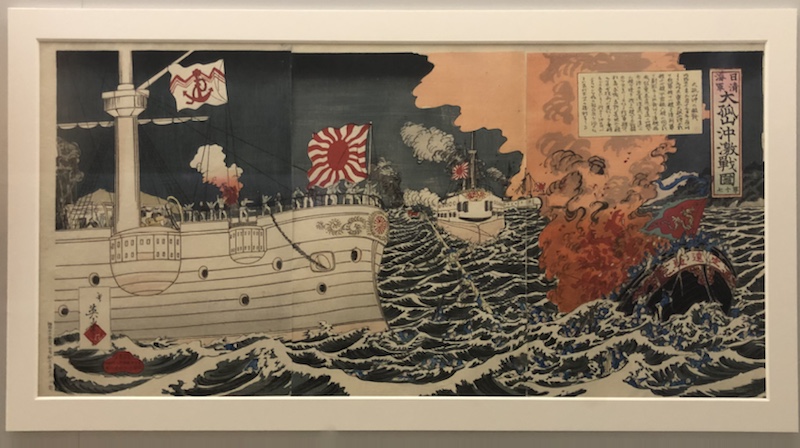
The pictorial report of the naval battle had a marked propagandistic character.
海軍戦闘の絵による報告は、顕著な宣伝効果的性質があった。
The Dingyuan – one of the two Chinese ironclad battleship with heavy artillery – suffered minor damage during the battle.
重砲を伴った2つの中国装甲艦のうちの1つである「定遠」は、戦闘中に軽微な被害しか受けなかった。
However, a dramatic explosion on the Chinese vessel can be seen in the adjacent hexaptych at the right.
しかし中国船の巨大な爆発を6枚絵の右側に見ることができる。
This triptych even shows the Dingyuan foundering.
3枚絵では「定遠」の沈没さえ描かれている。
In reality, the ironclad withstood the Japanese shelling relatively unscathed.
実際には、その装甲艦は日本の砲撃に対して比較的無傷で耐えたのだった。
・Our Fleet Crushing the Chinese Fleet off Dagushan:大狐山沖我艦清鑑撃破ス

In September 1894 Japanese ships attacked the Chinese Northern Fleet off the Chinese-Korean coast.
1894年9月、日本艦隊は中韓沖の中国北海軍を攻撃した。
Although the Chinese vessels were larger and had more powerful artillery, they were no match for the swifter Japanese warships.
中国船の方が巨大で強力な大砲を持っていたが、それらはより速い日本の軍艦に歯が立たなかった。
Both sides suffered heavy issues, but after a battle lasting five hours the Japanese victory was a fact.
どちらも大きな問題に苦しんだが、5時間続く戦闘の末、日本が勝利に至った。
・Enemy Ships Detrerred at Haiyangdao:海洋嶋附近ニ敵艦ヲ打沈
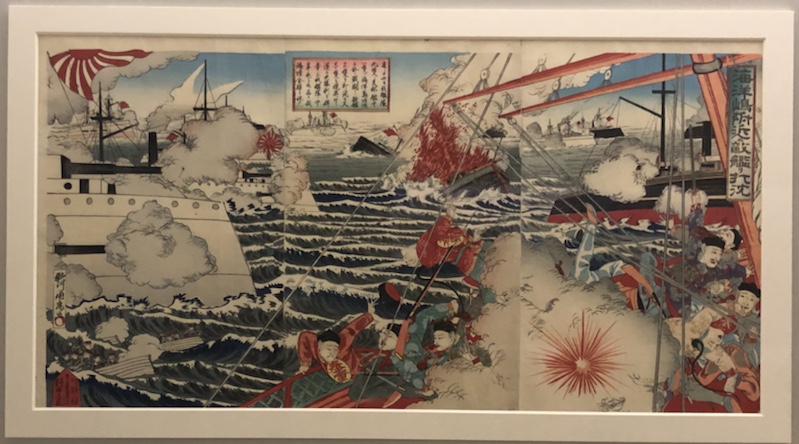
In the struggle for power in Korea between the Chinese and the Japanese armies it was vital to safeguard the equipment and provisioning of the troops.
朝鮮支配をめぐる中国と日本の戦いでは、装備と軍隊の支給を守ることが必要不可欠だった。
To this end, control of the Yellow Sea between the Korean Peninsula and Chinese mainland was crucial.
最終的に、朝鮮半島と中国本土の間に位置する黄海が重要だった。
The Japanese strategy was to force a decisive battle with the Chinese navy.
日本の作戦は中国海軍と決定的な戦闘を強行することだった。
・Great Victory of the Japanese Army at Asan in Korea:朝鮮牙山日本陸軍大勝利
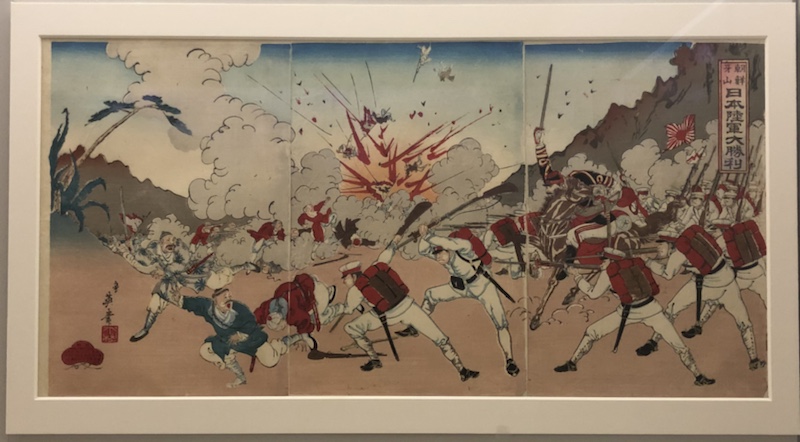
The Battle of Seonghwan was followed by a victory at the Bay of Asan.
成歓の戦闘に続いて、牙山湾で勝利した。
While we see a fierce battle, no fighting actually took place at Asan.
熾烈な戦いの様子が絵には描かれているが、実際には牙山で戦いは起きなかった。
The Chinese army had already abandoned its position prior to the arrival of the Japanese.
中国軍は日本軍が到着する前に、既にその地位を放棄していた。
These kinds of prints were often designed in Japan on the basis of reports from the front.
このような種類の絵は、前線からの報告によって日本でしばしば描かれた。
・The triumphant Return of the Japanese Army after the Great Victory at Seonghwan:日本兵凱旋の図
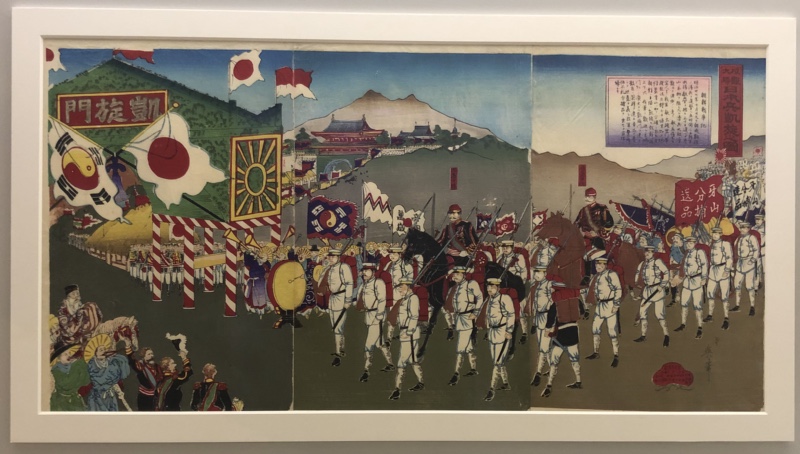
After a rebellion among the Korean population in the summer of 1894, the Korean court was compelled to invoke the help of the Chinese army.
1894年の夏に朝鮮の人々の間で反乱が起こった後に、朝鮮の裁判所は中国軍の助けを借りることを余儀なくされた。
When Japan became involved, the conflict rapidly escalated.
日本が関与するようになると、紛争は急速に拡大した。
The first dights broke out at the end of July.
最初の戦いは7月に起こった。
The Japanese scored a major victory at the Battle os Seonghwan.
日本は成歓の戦いで大勝利を収めた。
Here we see their triumphant return to the capital of Seoul.
この絵の中に首都ソウルへの凱旋を見ることができる。
・Flowers for the Imperial Headquarters in HIroshima:広島大本営行幸の図
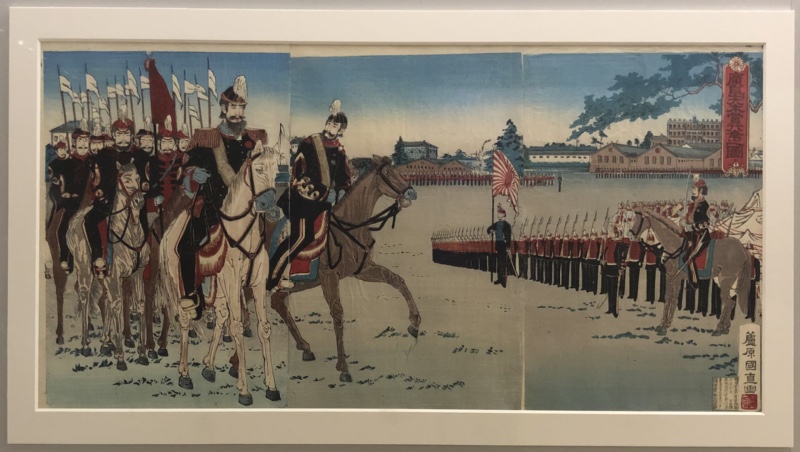
The Imperial Headquarters in Hiroshima was completed in 1894 as the new facility for the mordenized Japanese army.
広島の帝国本部は1894年に近代化された日本軍のための施設として完成した。
This print shows the recently built complex with the Japanese army standing in formation.
この絵は日本軍の編成に関して最近建てられた複合建設を示している。
The print may have been made to mark the visit of the Japanese emperor that year.
この絵はこの年の日本の天皇の行幸を記念するために作られたのだろう。
・日清戦争の絵は絵として興味深く、高い表現力に圧倒される
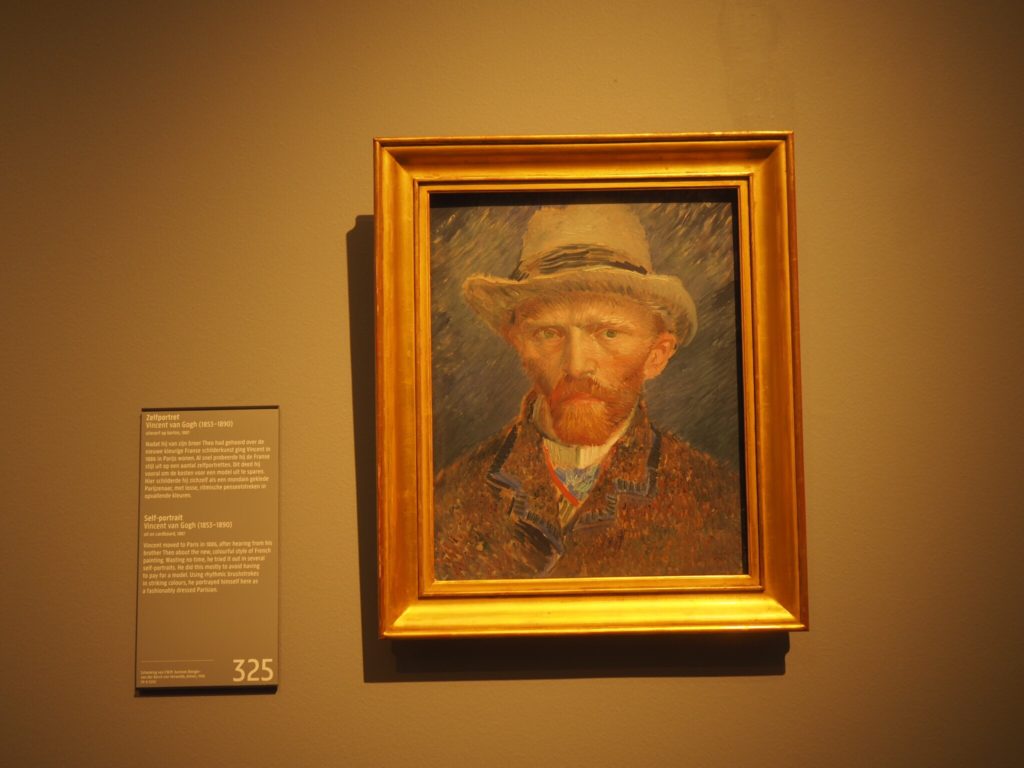
このように見ていくと、やはり日本人の戦争に対する意識を高めるためか、日本軍がやたらと強く誇らしい成果を残したということが絵の中では強調されており、アムステルダム国立美術館の説明も、おおよそ絵の内容に沿った解説がなされているようだった。しかし絵の中では派手に起きている戦闘も実際には起きていないことをバラしてしまうなど、客観的な説明も加えられていて興味深い。戦争への意識を掻き立てる絵の内容はさておき、迫力ある戦闘シーンなどやはり日本人は昔から絵が得意だったのだろうと感心せざるを得ない。このような躍動感ある表現方法が、やがて漫画という日本を代表する文化を花開かせるのに役立ったのではないだろうか。政治的な思想や戦争への嫌悪などを取っ払って純粋な目でこの絵を鑑賞した時、やはり絵そのものとして心を惹きつけられる巧みな表現力があるのではないだろうか。だからこそこのような政治的な代物であるにもかかわらず、アムステルダム国立美術館に展示されているのだろう。












